Environmental Science: A Literature Review on Nano-Technology Examples
VerifiedAdded on 2020/10/22
|7
|1471
|173
Literature Review
AI Summary
This literature review explores the application of nano-technology within environmental science, examining its definition, purpose, and structure. It delves into scientific methods used in the field and provides examples such as nano-adsorbents and carbon nanotubes for waste water treatment. The review emphasizes the role of nano-technology in addressing environmental challenges and improving treatment efficiency, highlighting the potential of nano-materials like carbon nanotubes to remove heavy metals and organic contaminants. The review also references key literature sources, providing a comprehensive overview of the subject.
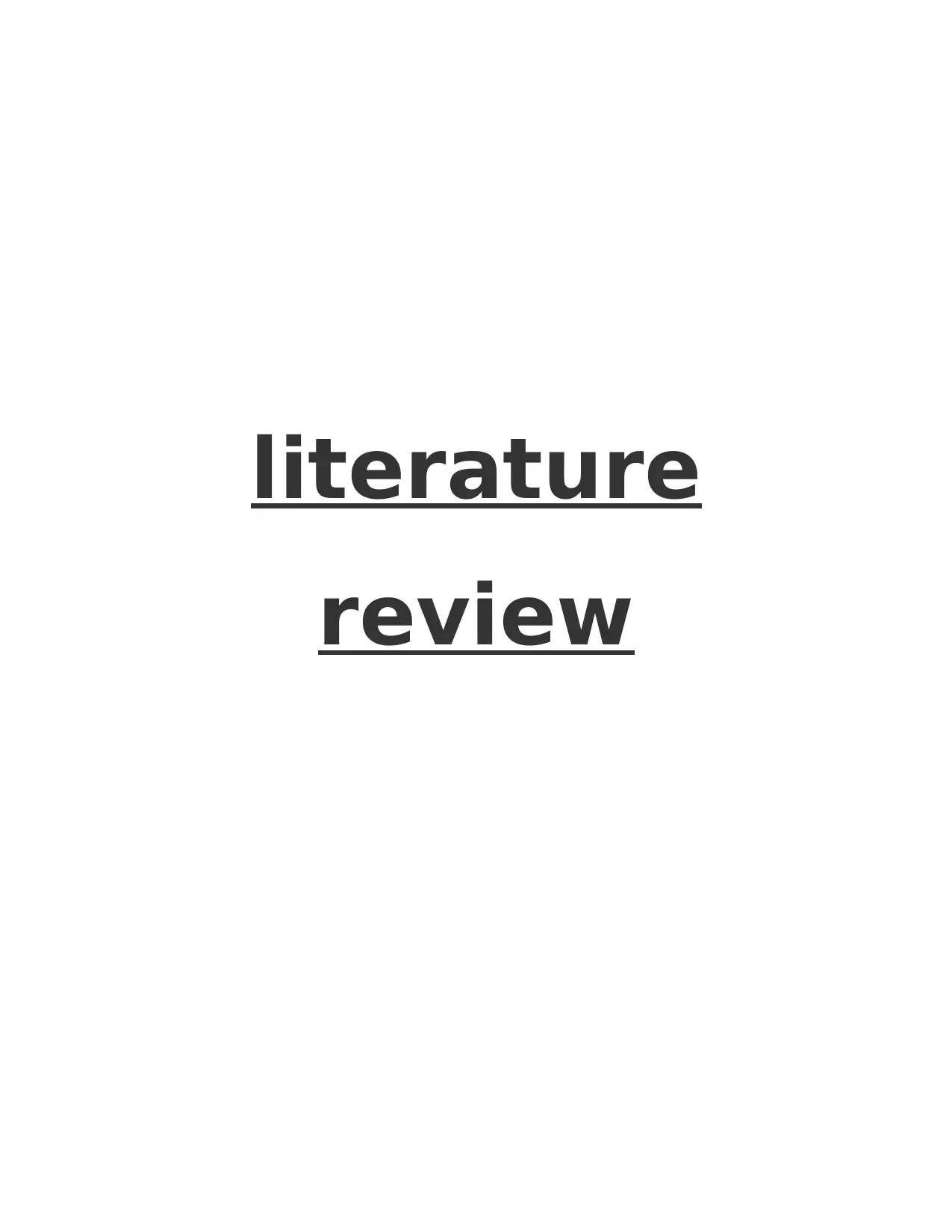
literature
review
review
Paraphrase This Document
Need a fresh take? Get an instant paraphrase of this document with our AI Paraphraser
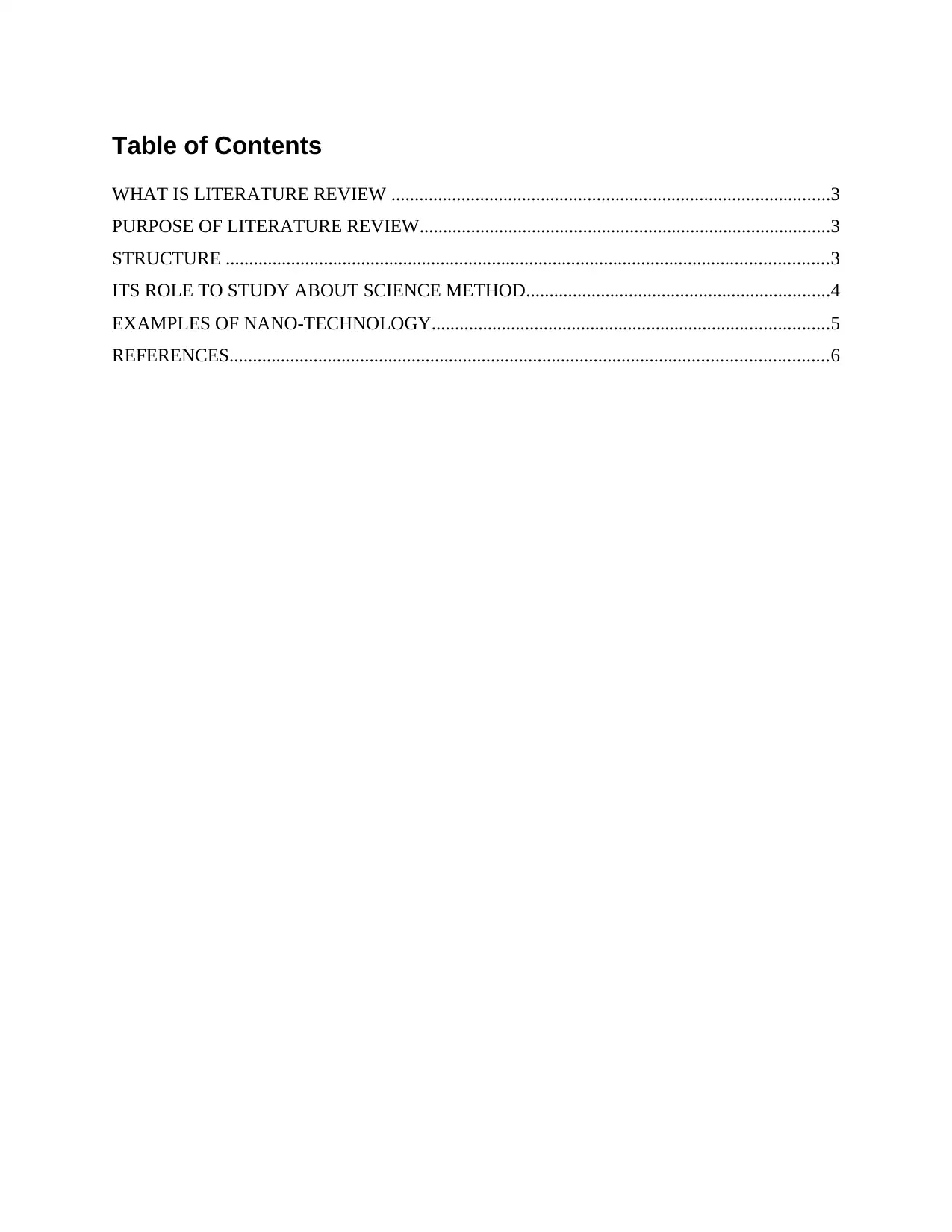
Table of Contents
WHAT IS LITERATURE REVIEW ..............................................................................................3
PURPOSE OF LITERATURE REVIEW........................................................................................3
STRUCTURE .................................................................................................................................3
ITS ROLE TO STUDY ABOUT SCIENCE METHOD.................................................................4
EXAMPLES OF NANO-TECHNOLOGY.....................................................................................5
REFERENCES................................................................................................................................6
WHAT IS LITERATURE REVIEW ..............................................................................................3
PURPOSE OF LITERATURE REVIEW........................................................................................3
STRUCTURE .................................................................................................................................3
ITS ROLE TO STUDY ABOUT SCIENCE METHOD.................................................................4
EXAMPLES OF NANO-TECHNOLOGY.....................................................................................5
REFERENCES................................................................................................................................6
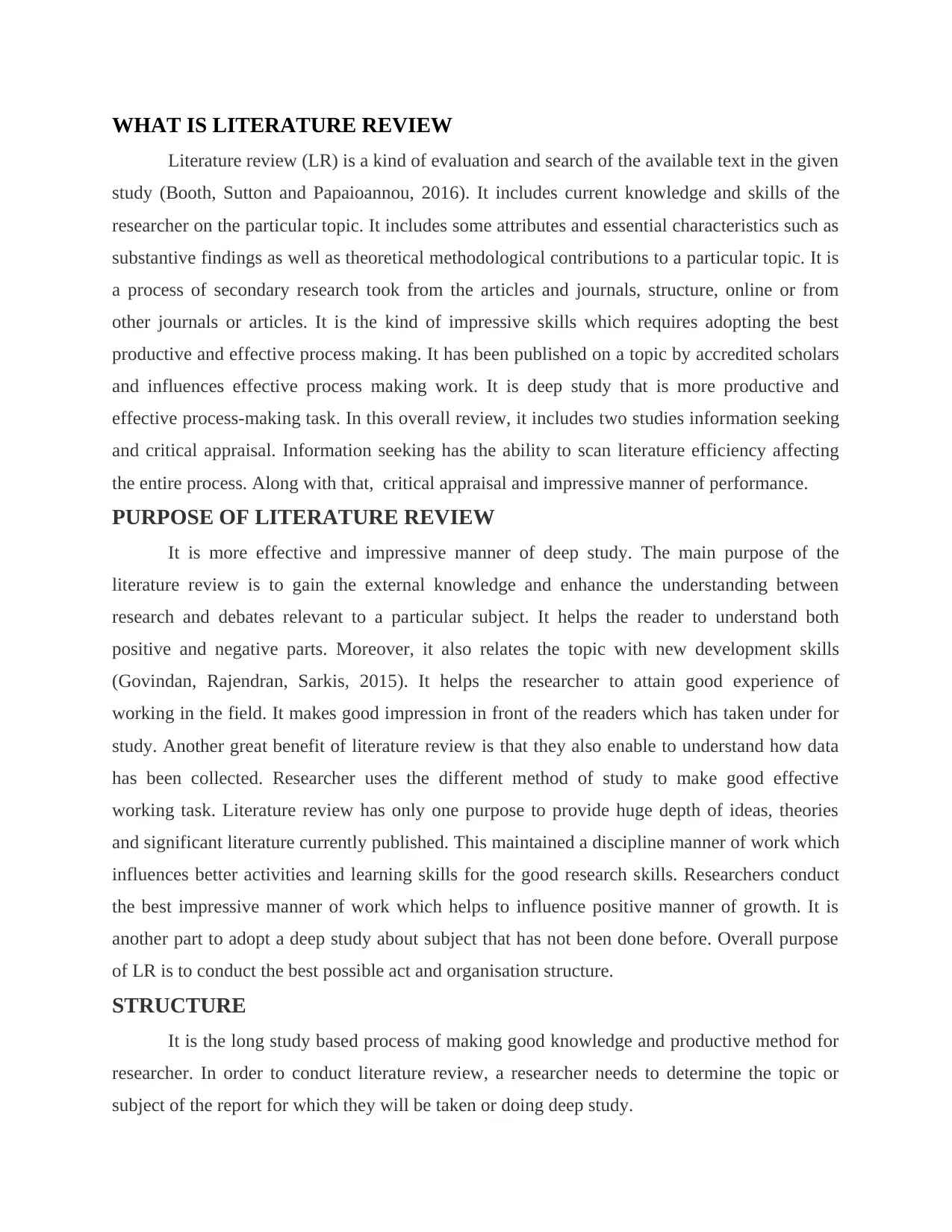
WHAT IS LITERATURE REVIEW
Literature review (LR) is a kind of evaluation and search of the available text in the given
study (Booth, Sutton and Papaioannou, 2016). It includes current knowledge and skills of the
researcher on the particular topic. It includes some attributes and essential characteristics such as
substantive findings as well as theoretical methodological contributions to a particular topic. It is
a process of secondary research took from the articles and journals, structure, online or from
other journals or articles. It is the kind of impressive skills which requires adopting the best
productive and effective process making. It has been published on a topic by accredited scholars
and influences effective process making work. It is deep study that is more productive and
effective process-making task. In this overall review, it includes two studies information seeking
and critical appraisal. Information seeking has the ability to scan literature efficiency affecting
the entire process. Along with that, critical appraisal and impressive manner of performance.
PURPOSE OF LITERATURE REVIEW
It is more effective and impressive manner of deep study. The main purpose of the
literature review is to gain the external knowledge and enhance the understanding between
research and debates relevant to a particular subject. It helps the reader to understand both
positive and negative parts. Moreover, it also relates the topic with new development skills
(Govindan, Rajendran, Sarkis, 2015). It helps the researcher to attain good experience of
working in the field. It makes good impression in front of the readers which has taken under for
study. Another great benefit of literature review is that they also enable to understand how data
has been collected. Researcher uses the different method of study to make good effective
working task. Literature review has only one purpose to provide huge depth of ideas, theories
and significant literature currently published. This maintained a discipline manner of work which
influences better activities and learning skills for the good research skills. Researchers conduct
the best impressive manner of work which helps to influence positive manner of growth. It is
another part to adopt a deep study about subject that has not been done before. Overall purpose
of LR is to conduct the best possible act and organisation structure.
STRUCTURE
It is the long study based process of making good knowledge and productive method for
researcher. In order to conduct literature review, a researcher needs to determine the topic or
subject of the report for which they will be taken or doing deep study.
Literature review (LR) is a kind of evaluation and search of the available text in the given
study (Booth, Sutton and Papaioannou, 2016). It includes current knowledge and skills of the
researcher on the particular topic. It includes some attributes and essential characteristics such as
substantive findings as well as theoretical methodological contributions to a particular topic. It is
a process of secondary research took from the articles and journals, structure, online or from
other journals or articles. It is the kind of impressive skills which requires adopting the best
productive and effective process making. It has been published on a topic by accredited scholars
and influences effective process making work. It is deep study that is more productive and
effective process-making task. In this overall review, it includes two studies information seeking
and critical appraisal. Information seeking has the ability to scan literature efficiency affecting
the entire process. Along with that, critical appraisal and impressive manner of performance.
PURPOSE OF LITERATURE REVIEW
It is more effective and impressive manner of deep study. The main purpose of the
literature review is to gain the external knowledge and enhance the understanding between
research and debates relevant to a particular subject. It helps the reader to understand both
positive and negative parts. Moreover, it also relates the topic with new development skills
(Govindan, Rajendran, Sarkis, 2015). It helps the researcher to attain good experience of
working in the field. It makes good impression in front of the readers which has taken under for
study. Another great benefit of literature review is that they also enable to understand how data
has been collected. Researcher uses the different method of study to make good effective
working task. Literature review has only one purpose to provide huge depth of ideas, theories
and significant literature currently published. This maintained a discipline manner of work which
influences better activities and learning skills for the good research skills. Researchers conduct
the best impressive manner of work which helps to influence positive manner of growth. It is
another part to adopt a deep study about subject that has not been done before. Overall purpose
of LR is to conduct the best possible act and organisation structure.
STRUCTURE
It is the long study based process of making good knowledge and productive method for
researcher. In order to conduct literature review, a researcher needs to determine the topic or
subject of the report for which they will be taken or doing deep study.
⊘ This is a preview!⊘
Do you want full access?
Subscribe today to unlock all pages.

Trusted by 1+ million students worldwide
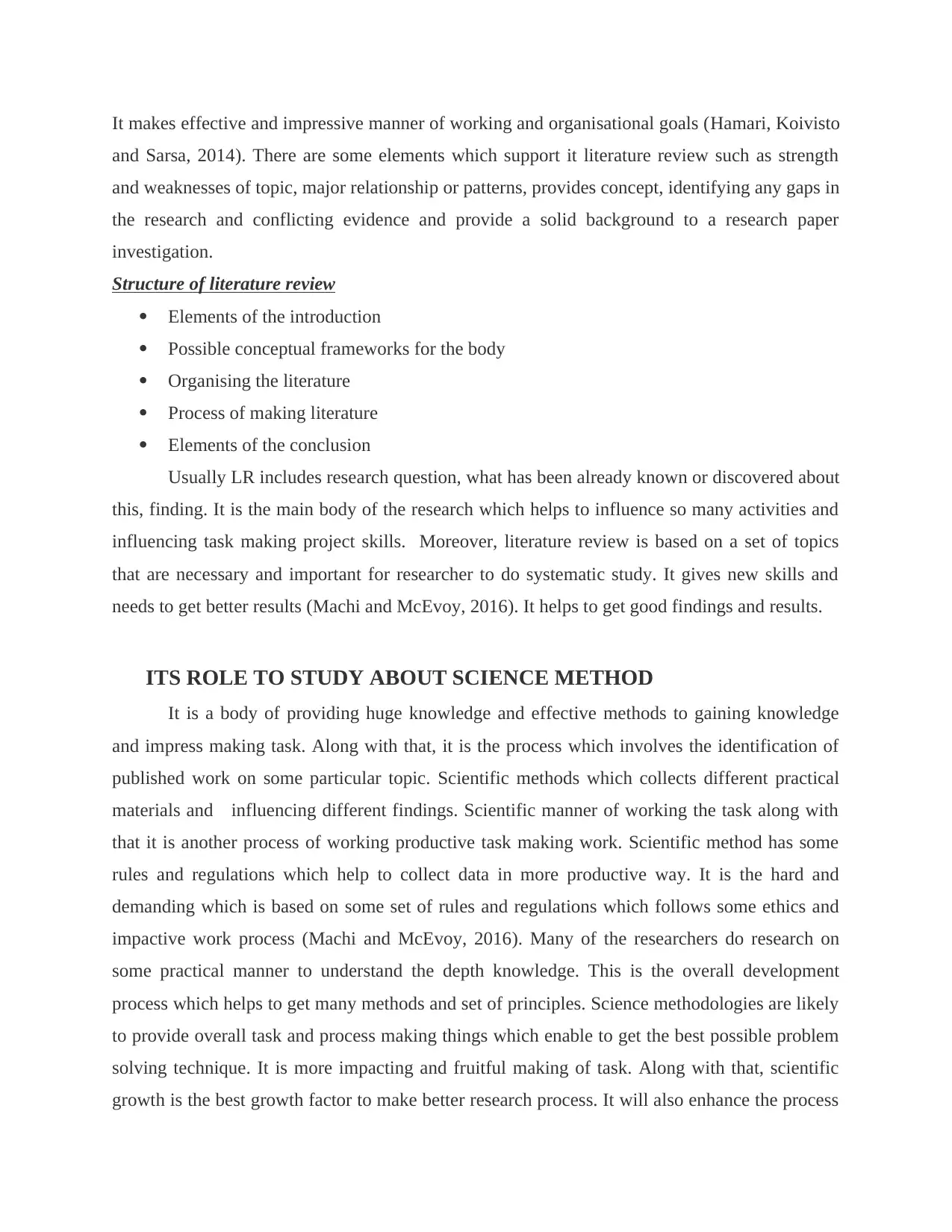
It makes effective and impressive manner of working and organisational goals (Hamari, Koivisto
and Sarsa, 2014). There are some elements which support it literature review such as strength
and weaknesses of topic, major relationship or patterns, provides concept, identifying any gaps in
the research and conflicting evidence and provide a solid background to a research paper
investigation.
Structure of literature review
Elements of the introduction
Possible conceptual frameworks for the body
Organising the literature
Process of making literature
Elements of the conclusion
Usually LR includes research question, what has been already known or discovered about
this, finding. It is the main body of the research which helps to influence so many activities and
influencing task making project skills. Moreover, literature review is based on a set of topics
that are necessary and important for researcher to do systematic study. It gives new skills and
needs to get better results (Machi and McEvoy, 2016). It helps to get good findings and results.
ITS ROLE TO STUDY ABOUT SCIENCE METHOD
It is a body of providing huge knowledge and effective methods to gaining knowledge
and impress making task. Along with that, it is the process which involves the identification of
published work on some particular topic. Scientific methods which collects different practical
materials and influencing different findings. Scientific manner of working the task along with
that it is another process of working productive task making work. Scientific method has some
rules and regulations which help to collect data in more productive way. It is the hard and
demanding which is based on some set of rules and regulations which follows some ethics and
impactive work process (Machi and McEvoy, 2016). Many of the researchers do research on
some practical manner to understand the depth knowledge. This is the overall development
process which helps to get many methods and set of principles. Science methodologies are likely
to provide overall task and process making things which enable to get the best possible problem
solving technique. It is more impacting and fruitful making of task. Along with that, scientific
growth is the best growth factor to make better research process. It will also enhance the process
and Sarsa, 2014). There are some elements which support it literature review such as strength
and weaknesses of topic, major relationship or patterns, provides concept, identifying any gaps in
the research and conflicting evidence and provide a solid background to a research paper
investigation.
Structure of literature review
Elements of the introduction
Possible conceptual frameworks for the body
Organising the literature
Process of making literature
Elements of the conclusion
Usually LR includes research question, what has been already known or discovered about
this, finding. It is the main body of the research which helps to influence so many activities and
influencing task making project skills. Moreover, literature review is based on a set of topics
that are necessary and important for researcher to do systematic study. It gives new skills and
needs to get better results (Machi and McEvoy, 2016). It helps to get good findings and results.
ITS ROLE TO STUDY ABOUT SCIENCE METHOD
It is a body of providing huge knowledge and effective methods to gaining knowledge
and impress making task. Along with that, it is the process which involves the identification of
published work on some particular topic. Scientific methods which collects different practical
materials and influencing different findings. Scientific manner of working the task along with
that it is another process of working productive task making work. Scientific method has some
rules and regulations which help to collect data in more productive way. It is the hard and
demanding which is based on some set of rules and regulations which follows some ethics and
impactive work process (Machi and McEvoy, 2016). Many of the researchers do research on
some practical manner to understand the depth knowledge. This is the overall development
process which helps to get many methods and set of principles. Science methodologies are likely
to provide overall task and process making things which enable to get the best possible problem
solving technique. It is more impacting and fruitful making of task. Along with that, scientific
growth is the best growth factor to make better research process. It will also enhance the process
Paraphrase This Document
Need a fresh take? Get an instant paraphrase of this document with our AI Paraphraser
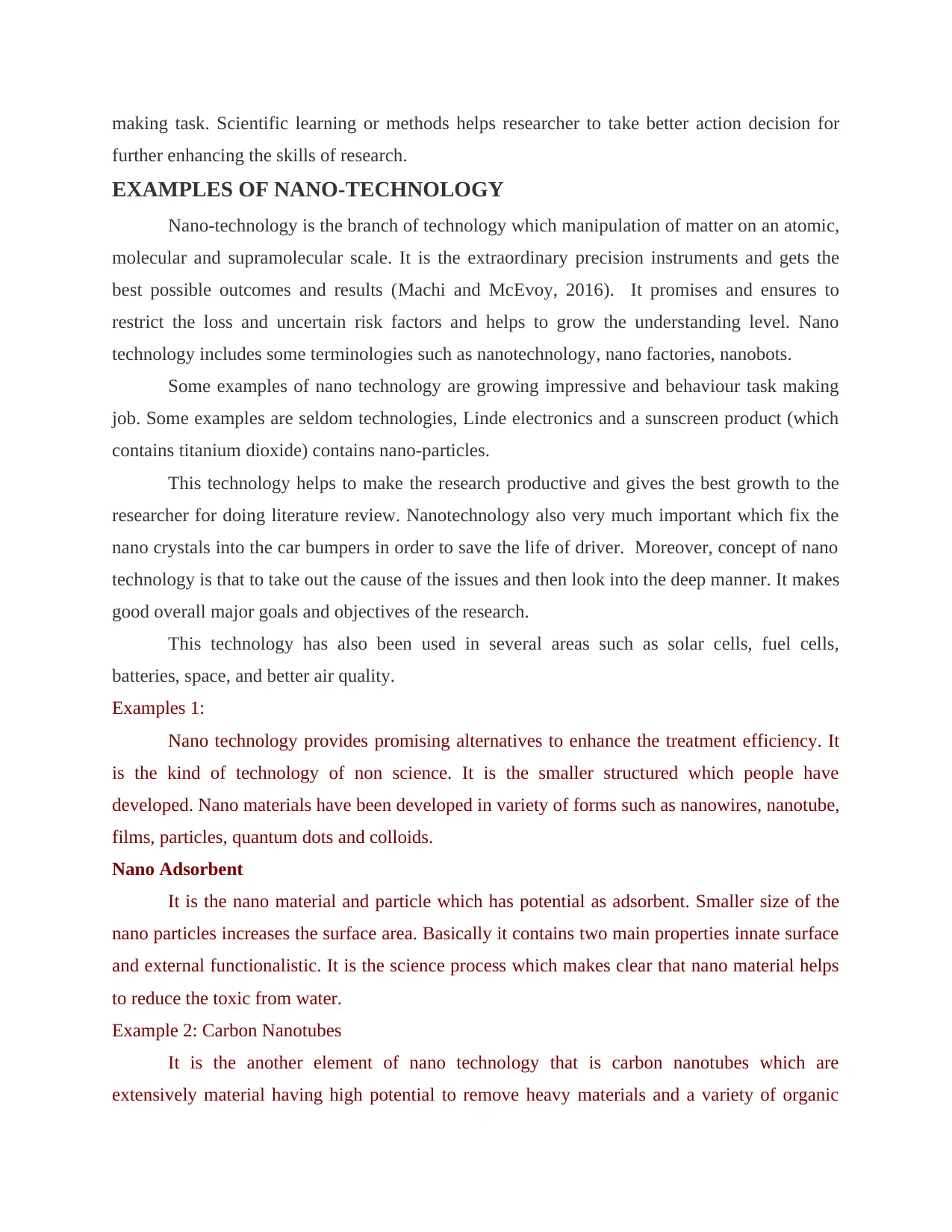
making task. Scientific learning or methods helps researcher to take better action decision for
further enhancing the skills of research.
EXAMPLES OF NANO-TECHNOLOGY
Nano-technology is the branch of technology which manipulation of matter on an atomic,
molecular and supramolecular scale. It is the extraordinary precision instruments and gets the
best possible outcomes and results (Machi and McEvoy, 2016). It promises and ensures to
restrict the loss and uncertain risk factors and helps to grow the understanding level. Nano
technology includes some terminologies such as nanotechnology, nano factories, nanobots.
Some examples of nano technology are growing impressive and behaviour task making
job. Some examples are seldom technologies, Linde electronics and a sunscreen product (which
contains titanium dioxide) contains nano-particles.
This technology helps to make the research productive and gives the best growth to the
researcher for doing literature review. Nanotechnology also very much important which fix the
nano crystals into the car bumpers in order to save the life of driver. Moreover, concept of nano
technology is that to take out the cause of the issues and then look into the deep manner. It makes
good overall major goals and objectives of the research.
This technology has also been used in several areas such as solar cells, fuel cells,
batteries, space, and better air quality.
Examples 1:
Nano technology provides promising alternatives to enhance the treatment efficiency. It
is the kind of technology of non science. It is the smaller structured which people have
developed. Nano materials have been developed in variety of forms such as nanowires, nanotube,
films, particles, quantum dots and colloids.
Nano Adsorbent
It is the nano material and particle which has potential as adsorbent. Smaller size of the
nano particles increases the surface area. Basically it contains two main properties innate surface
and external functionalistic. It is the science process which makes clear that nano material helps
to reduce the toxic from water.
Example 2: Carbon Nanotubes
It is the another element of nano technology that is carbon nanotubes which are
extensively material having high potential to remove heavy materials and a variety of organic
further enhancing the skills of research.
EXAMPLES OF NANO-TECHNOLOGY
Nano-technology is the branch of technology which manipulation of matter on an atomic,
molecular and supramolecular scale. It is the extraordinary precision instruments and gets the
best possible outcomes and results (Machi and McEvoy, 2016). It promises and ensures to
restrict the loss and uncertain risk factors and helps to grow the understanding level. Nano
technology includes some terminologies such as nanotechnology, nano factories, nanobots.
Some examples of nano technology are growing impressive and behaviour task making
job. Some examples are seldom technologies, Linde electronics and a sunscreen product (which
contains titanium dioxide) contains nano-particles.
This technology helps to make the research productive and gives the best growth to the
researcher for doing literature review. Nanotechnology also very much important which fix the
nano crystals into the car bumpers in order to save the life of driver. Moreover, concept of nano
technology is that to take out the cause of the issues and then look into the deep manner. It makes
good overall major goals and objectives of the research.
This technology has also been used in several areas such as solar cells, fuel cells,
batteries, space, and better air quality.
Examples 1:
Nano technology provides promising alternatives to enhance the treatment efficiency. It
is the kind of technology of non science. It is the smaller structured which people have
developed. Nano materials have been developed in variety of forms such as nanowires, nanotube,
films, particles, quantum dots and colloids.
Nano Adsorbent
It is the nano material and particle which has potential as adsorbent. Smaller size of the
nano particles increases the surface area. Basically it contains two main properties innate surface
and external functionalistic. It is the science process which makes clear that nano material helps
to reduce the toxic from water.
Example 2: Carbon Nanotubes
It is the another element of nano technology that is carbon nanotubes which are
extensively material having high potential to remove heavy materials and a variety of organic
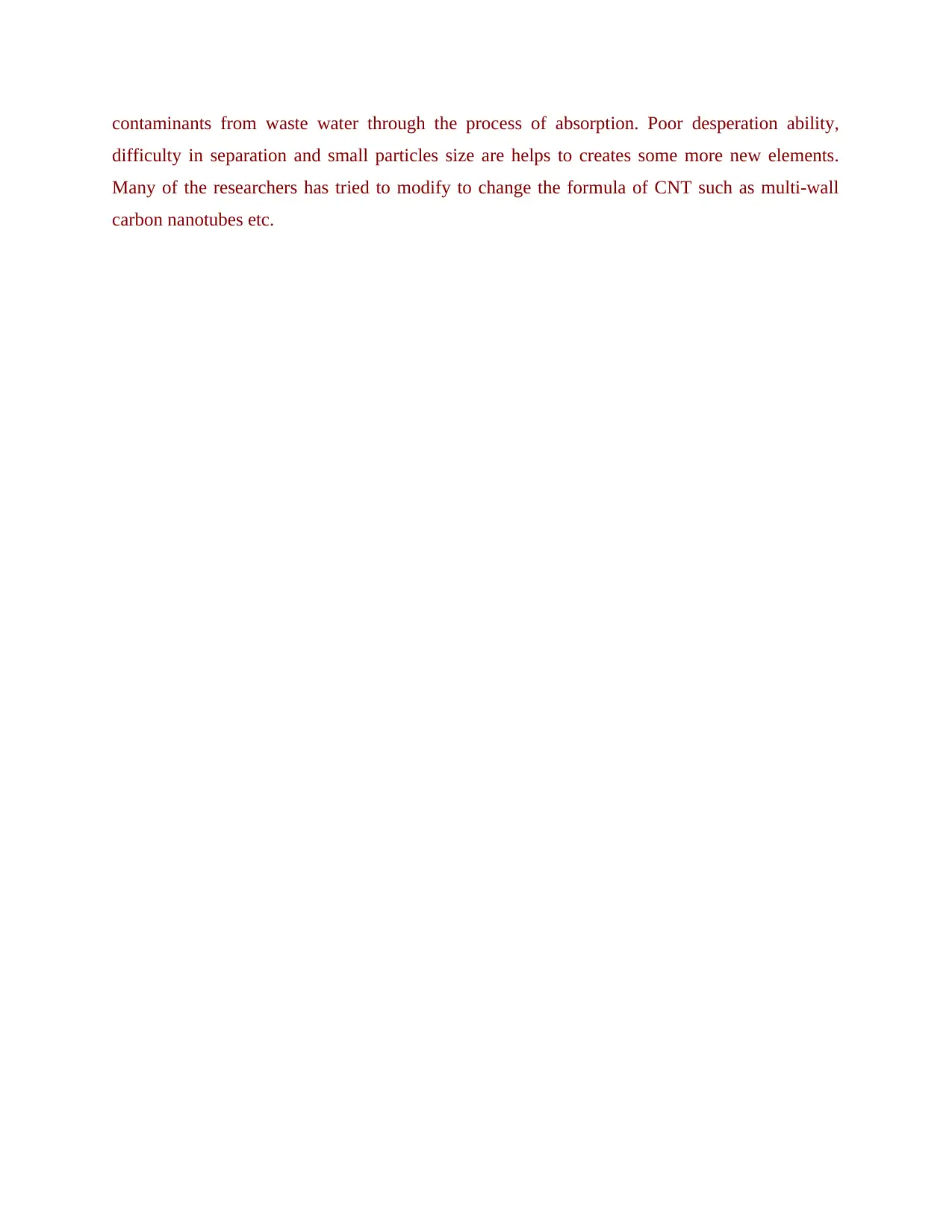
contaminants from waste water through the process of absorption. Poor desperation ability,
difficulty in separation and small particles size are helps to creates some more new elements.
Many of the researchers has tried to modify to change the formula of CNT such as multi-wall
carbon nanotubes etc.
difficulty in separation and small particles size are helps to creates some more new elements.
Many of the researchers has tried to modify to change the formula of CNT such as multi-wall
carbon nanotubes etc.
⊘ This is a preview!⊘
Do you want full access?
Subscribe today to unlock all pages.

Trusted by 1+ million students worldwide
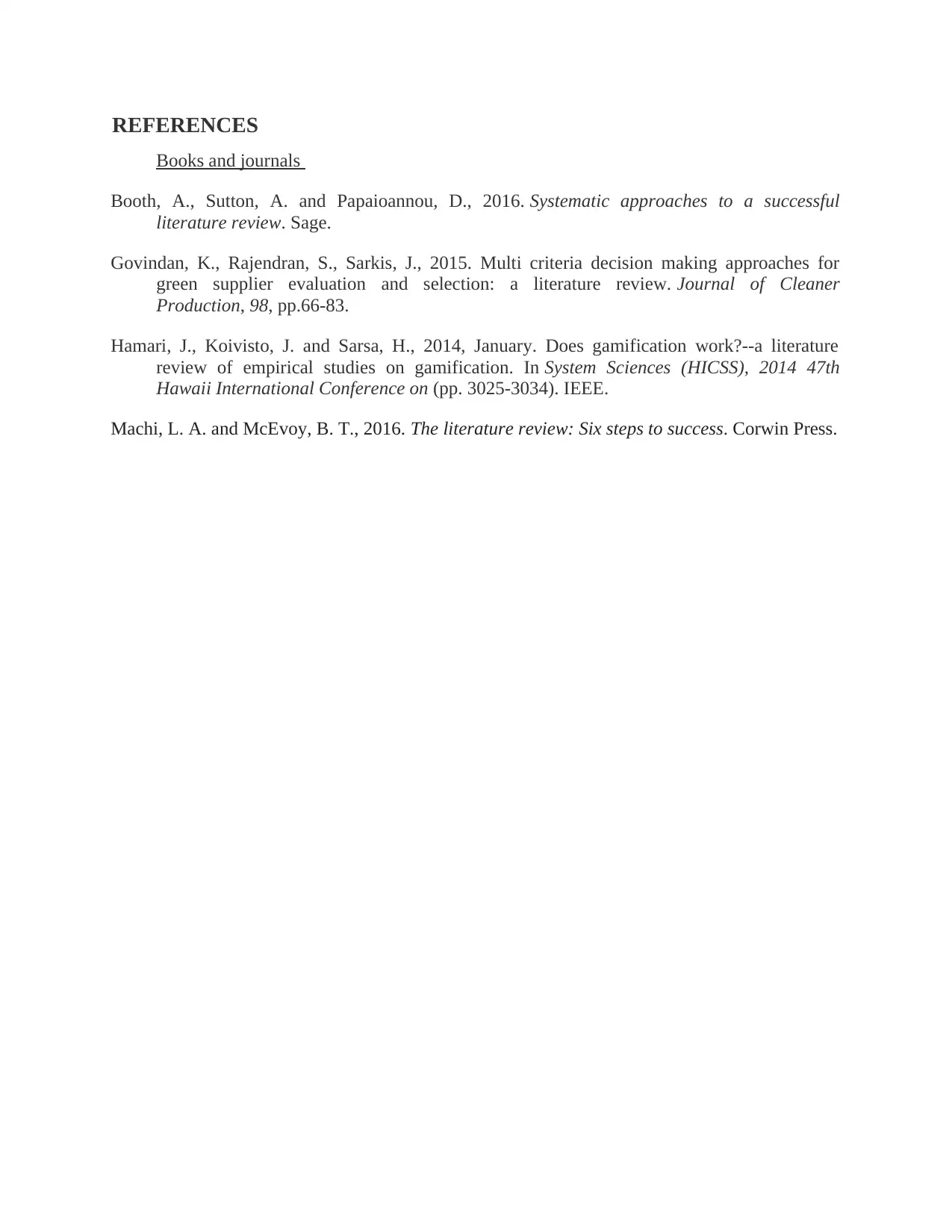
REFERENCES
Books and journals
Booth, A., Sutton, A. and Papaioannou, D., 2016. Systematic approaches to a successful
literature review. Sage.
Govindan, K., Rajendran, S., Sarkis, J., 2015. Multi criteria decision making approaches for
green supplier evaluation and selection: a literature review. Journal of Cleaner
Production, 98, pp.66-83.
Hamari, J., Koivisto, J. and Sarsa, H., 2014, January. Does gamification work?--a literature
review of empirical studies on gamification. In System Sciences (HICSS), 2014 47th
Hawaii International Conference on (pp. 3025-3034). IEEE.
Machi, L. A. and McEvoy, B. T., 2016. The literature review: Six steps to success. Corwin Press.
Books and journals
Booth, A., Sutton, A. and Papaioannou, D., 2016. Systematic approaches to a successful
literature review. Sage.
Govindan, K., Rajendran, S., Sarkis, J., 2015. Multi criteria decision making approaches for
green supplier evaluation and selection: a literature review. Journal of Cleaner
Production, 98, pp.66-83.
Hamari, J., Koivisto, J. and Sarsa, H., 2014, January. Does gamification work?--a literature
review of empirical studies on gamification. In System Sciences (HICSS), 2014 47th
Hawaii International Conference on (pp. 3025-3034). IEEE.
Machi, L. A. and McEvoy, B. T., 2016. The literature review: Six steps to success. Corwin Press.
1 out of 7
Related Documents
Your All-in-One AI-Powered Toolkit for Academic Success.
+13062052269
info@desklib.com
Available 24*7 on WhatsApp / Email
![[object Object]](/_next/static/media/star-bottom.7253800d.svg)
Unlock your academic potential
Copyright © 2020–2025 A2Z Services. All Rights Reserved. Developed and managed by ZUCOL.





